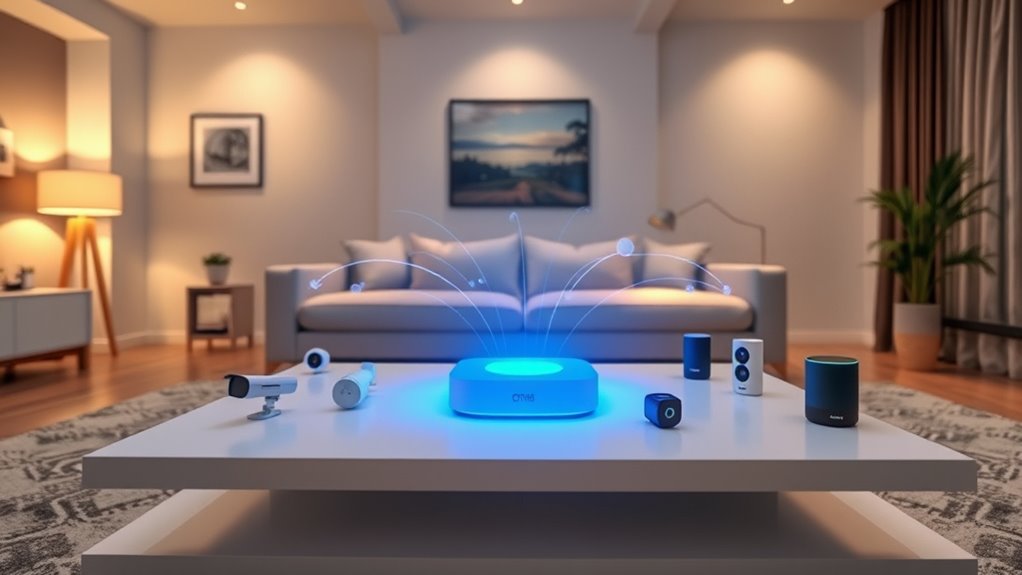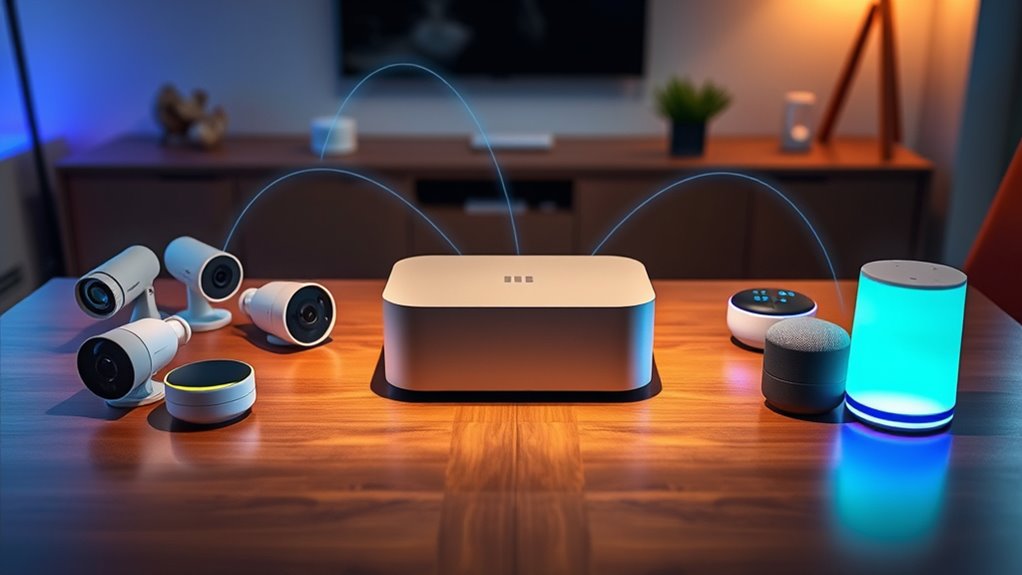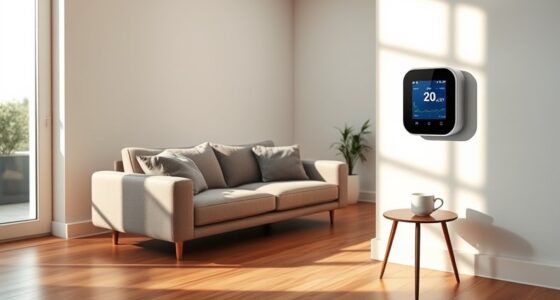A smart home hub is essential because it centralizes device management, making it easier to control and coordinate all your gadgets through one interface. It simplifies integration across different platforms and protocols, reducing the need for multiple apps and remotes. Plus, it boosts security by unifying security devices and automating responses. With a hub, your home becomes more efficient, secure, and responsive—if you stay tuned, you’ll discover how it truly transforms your smart living experience.
Key Takeaways
- Centralizes device management, simplifying control and updates across multiple smart devices and platforms.
- Enhances voice command accuracy by consolidating signals from various devices.
- Improves security by integrating cameras, locks, and alarms into a unified system for coordinated responses.
- Eases troubleshooting and firmware updates through a single interface, saving time and reducing compatibility issues.
- Boosts energy efficiency and cost savings by automating routines and optimizing device operations.

Have you ever wondered how to seamlessly connect all your smart devices? The answer is a smart home hub. Without one, your devices can feel scattered, operating on different platforms and protocols, which makes managing them a hassle. A hub acts as the central nervous system, bringing everything together in a cohesive, easy-to-control system. With a hub, you can streamline your smart home experience, making daily routines smoother and more intuitive.
A smart home hub simplifies device management, creating a cohesive, easy-to-control smart home experience.
One of the biggest benefits of using a hub is voice control. Instead of juggling multiple apps or remotes, a hub allows you to command your entire smart home using simple voice commands. You can ask your device to turn on the lights, adjust the thermostat, or lock the doors—all with your voice. This not only offers convenience but also creates a more natural way to interact with your home. Voice control becomes more accurate and responsive when integrated through a hub, as it consolidates signals from various devices and protocols, ensuring commands are executed swiftly and reliably.
Security integration is another essential reason to invest in a hub. When your smart home devices are connected through a central hub, you can better coordinate security features like cameras, doorbells, and smart locks. Instead of managing each device individually, the hub provides a unified interface to monitor and control all security aspects. If an unusual activity occurs, your hub can trigger automatic responses—like locking doors or activating alarms—and send alerts to your phone. This integration enhances your home’s safety by ensuring all security devices work together seamlessly, giving you peace of mind.
Beyond voice control and security, a hub simplifies updates and troubleshooting. Instead of updating each device separately, the hub manages firmware updates centrally, reducing the risk of compatibility issues. When problems arise, troubleshooting becomes easier because you can access all connected devices from a single app or interface, saving you time and frustration.
Additionally, a smart home hub can improve energy efficiency by optimizing device operation based on your routines and preferences, helping you save on utility bills.
Ultimately, a smart home hub is about making your life easier and safer. It eliminates the chaos of multiple platforms and disconnected devices, offering a unified, streamlined experience. With a hub, your smart home becomes more responsive, secure, and manageable. It bridges the gap between different technologies, making sure everything works together harmoniously. This not only boosts convenience but also maximizes your investment in smart home tech, transforming your house into a truly intelligent, integrated home that adapts effortlessly to your needs.
Frequently Asked Questions
Can I Connect Multiple Hubs in My Smart Home?
Yes, you can connect multiple hubs in your smart home, but it depends on hub compatibility. Using multiple hubs helps you manage different devices more effectively, especially if they operate on different protocols. Just make certain your hubs support device management across platforms to avoid conflicts. This way, you streamline your smart home setup, improve control, and ensure seamless operation across all your connected devices.
What Is the Average Cost of a Smart Home Hub?
The average cost of a smart home hub varies depending on features and brand, typically ranging from $50 to $300. When doing a cost comparison, consider not just the price but also the installation process—some hubs are easier to set up than others. Budget-friendly options work well for basic needs, while more advanced hubs offer greater compatibility and control, making your smart home more seamless and integrated.
How Secure Are Smart Home Hubs From Hacking?
Your smart home hub’s security is like a fortress, but no system is invincible. It’s generally quite secure, thanks to robust encryption protocols and regular security updates. However, cybersecurity vulnerabilities can still exist, especially if you don’t keep firmware up-to-date or use weak passwords. Staying vigilant by enabling multi-factor authentication and monitoring device activity helps protect your setup from hacking attempts, making your smart home safer.
Do Hubs Support Voice Control Integration?
Many smart home hubs support voice control integration, making your life easier. They typically offer voice command compatibility with popular voice assistants like Alexa, Google Assistant, or Siri. This allows you to control devices hands-free using voice commands. By choosing a hub that supports voice assistant integration, you enhance your smart home experience, enjoying seamless voice control and centralized management of all your connected devices effortlessly.
Can a Hub Work With Third-Party Smart Devices?
Imagine seamlessly blending your smart devices into a harmonious home. A hub often acts as that gentle bridge, supporting third-party smart devices and their device pairing methods. It enhances voice assistant compatibility, making your voice commands more effective. With a hub, you gain access to greater flexibility, allowing your diverse gadgets to work together effortlessly, creating a truly connected and intuitive living space that responds to your every need.
Conclusion
So, surprise! That tiny hub isn’t just a boring box — it’s the secret to a truly smart home. Without it, your devices might as well be speaking different languages, leaving you tangled in wires and frustration. Ironically, the very thing that seems like an extra step is what makes everything work seamlessly. So go ahead, embrace the hub — your future self will thank you for avoiding chaos and embracing simplicity.









